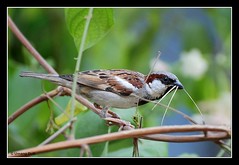Spotted this sparrow collecting straw to build its nest .. love the way it had the straws in its beak
The House Sparrow (Passer domesticus) is a member of the Old World sparrow family Passeridae, and is, somewhat controversially, considered a relative of the Weaver Finch Family. It occurs naturally in most of Europe and much of Asia. It has also followed humans all over the world and has been intentionally or accidentally introduced to most of the Americas, sub-Saharan Africa, New Zealand and Australia as well as urban areas in other parts of the world. It is now the most widely distributed wild bird on the planet
Wherever people build, House Sparrows sooner or later come to share their abodes. Though described as tame and semi-domestic, neither is strictly true; humans provide food and home, not companionship. The House Sparrow remains wary of man.
This 14 to 16 centimetre long bird is abundant in temperate climates, but not universally common; in many hilly districts it is scarce. In cities, towns and villages, even around isolated farms, it can be the most abundant bird.
The male House Sparrow has a grey crown, cheeks and underparts, black on the throat, upper breast and between the bill and eyes. The bill in summer is blue-black, and the legs are brown. In winter the plumage is dulled by pale edgings, and the bill is yellowish brown. The female has no black on head or throat, nor a grey crown; her upperparts are streaked with brown. The juveniles are deeper brown, and the white is replaced by buff; the beak is dull yellow. The House Sparrow is often confused with the smaller and slimmer Tree Sparrow, which, however, has a chestnut and not grey crown, two distinct wing bars, and a black patch on each cheek.



No comments:
Post a Comment